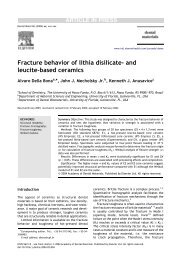Microleakage of various cementing agents for full cast crowns
Microleakage of various cementing agents for full cast crowns
Microleakage of various cementing agents for full cast crowns
You also want an ePaper? Increase the reach of your titles
YUMPU automatically turns print PDFs into web optimized ePapers that Google loves.
<strong>Microleakage</strong> <strong>of</strong> <strong>various</strong> <strong>cementing</strong> <strong>agents</strong> <strong>for</strong> <strong>full</strong> <strong>cast</strong> <strong>crowns</strong> 447<br />
relative constituents: Au 68.5%, Ag 12.0%, Cu 12.0%,<br />
Pt 6.9%, Zn 0.5%, Ir 0.1%; lots #4492 and 4269).<br />
The <strong>cast</strong>ings were divested, trimmed and seated<br />
using well-established procedures routinely used by<br />
dental laboratories <strong>for</strong> crown restorations. The fit<br />
<strong>of</strong> the <strong>cast</strong>ings was checked with silicone (Fit<br />
Checker; GC, Munich, Germany) and improved if<br />
necessary. Any points visibly pressed into the<br />
silicone were relieved using a small (0.08 mm in<br />
diameter) rotary instrument. The marginal fit <strong>of</strong> all<br />
<strong>cast</strong>ings was verified on the prepared residual teeth<br />
under a stereomicroscope (!32 magnification) and<br />
with an extra-fine probe (EXD5; Hu-Friedy, Chicago,<br />
IL, USA). Subsequently, the interior surface <strong>of</strong> the<br />
gold frameworks was sandblasted with Al 2O 3<br />
(Hasenfratz, Grafing, Germany; average grain<br />
size, 105 mm; pressure, 0.18 MPa; distance,<br />
10 mm; duration, 10 s).<br />
Our experimental set-up included one zincphosphate<br />
cement (Harvard cement), one conventional<br />
glass–ionomer cement (Fuji I), one resinmodified<br />
glass–ionomer cement (Fuji Plus), two<br />
standard dual-cure resin cements (RelyX ARC,<br />
Panavia F), and one recently developed dualcure<br />
self-adhesive resin cement (RelyX Unicem)<br />
(Table 1). All <strong>cementing</strong> <strong>agents</strong> were processed<br />
at room temperature (23 8C) strictly following<br />
the manufacturers’ instructions. Two cements<br />
(GC Fuji Plus and RelyX Unicem) were supplied<br />
in pre-measured capsules. Upon activation, these<br />
materials were mechanically triturated with the<br />
rotational mixing machine (CapMix; 3M ESPE,<br />
Seefeld, Germany) <strong>for</strong> the time recommended by<br />
the manufacturers (10 or 15 s). RelyX ARC was<br />
supplied in pre-measured delivery systems. Panavia<br />
F was mixed on a mixing block, using a hard<br />
plastic spatula, at a base-to-catalyst paste ratio <strong>of</strong><br />
1:1 <strong>for</strong> approximately 20 s. An oxygen-blocking gel<br />
(Oxyguard II; Kuraray, Osaka, Japan; lot #00373A)<br />
was applied <strong>for</strong> 3 min when Panavia F was used.<br />
Fuji I was manually mixed at a powder-to-liquid<br />
ratio <strong>of</strong> 1.8–1.0 <strong>for</strong> around 20 s. The powder-toliquid<br />
ratio <strong>of</strong> Harvard cement was determined by<br />
weighing according to the manufacturer’s instructions<br />
using an analytical balance (G1 mg). Mixing<br />
was per<strong>for</strong>med on a cool slab, over a wide area,<br />
to incorporate small increments <strong>of</strong> powder into<br />
the liquid <strong>for</strong> approximately 90 s (Harvard<br />
cement).<br />
Be<strong>for</strong>e cementation, all 60 teeth were randomized<br />
along with their gold frameworks to six test<br />
groups (nZ10). The interior surfaces <strong>of</strong> the crown<br />
restorations and the prepared teeth were cleaned<br />
with alcohol. All teeth, which were to receive the<br />
resin-modified glass–ionomer cement or a standard<br />
resin cement, were pretreated with dentin<br />
Table 1 Description <strong>of</strong> <strong>cementing</strong> <strong>agents</strong> used in this study.<br />
Materials Type Main composition a<br />
Adhesive system Manufacturer<br />
Harvard cement Zinc-phosphate P: zinc oxide, magnesia; No adhesive system Richter & H<strong>of</strong>fmann,<br />
(Batch No. powder<br />
2112498001, Batch<br />
No. liquid<br />
2111000013)<br />
cement<br />
L: phosphoric acid<br />
Berlin, Germany<br />
Fuji I (Batch No. Conventional P: polyacrylic acid, alu- No adhesive system GC Corp., Tokyo,<br />
0001251)<br />
glass–ionomer mino-silicate glass;<br />
Japan<br />
cement<br />
L: polyacrylic acid,<br />
citric acid<br />
Fuji Plus (Batch No. Resin-modified P: alumino-silicate Fuji Plus conditioner GC Corp., Tokyo,<br />
0009214)<br />
glass–ionomer glass; L: HEMA, poly-<br />
Japan<br />
cement<br />
acrylic acid, TEGDMA<br />
RelyX ARC (Batch No. Resin cement Bis-GMA, TEGDMA, silica Single bond adhesive 3M ESPE, Seefeld,<br />
CACA)<br />
and zirconium glass (Batch No. 4242) Germany<br />
Panavia F (Batch No. Resin cement BPEDMA, MDP, DMA, ED primer (Batch No. Kuraray, Osaka,<br />
base 00124A, Batch<br />
barium, boron and sili- 00108B, Batch No. Japan<br />
No. catalyst 00046A)<br />
cium glass, NaF<br />
00115B)<br />
RelyX Unicem (Batch Self-adhesive Phosphoric acid metha- No adhesive system 3M ESPE, Seefeld,<br />
No. 0001)<br />
universal resin crylates,dimethacry- Germany<br />
cement<br />
lates, inorganic fillers,<br />
fumed silica, initiators<br />
P, powder; L, liquid. Bis-GMA, bisphenol-A diglycidyl ether dimethacrylate; BPEDMA, bisphenol-A polyethoxydimethacrylate; DMA,<br />
aliphatic dimethacrlyate; HEMA, 2-hydroxyethylmethacrylat; MDP, 10-methacryloyloxy decyl dihydrogenphosphate; NaF, sodium<br />
fluoride; TEGDMA, triethylene glycol dimethacrylate.<br />
a According to the in<strong>for</strong>mation provided by the manufacturers.
















